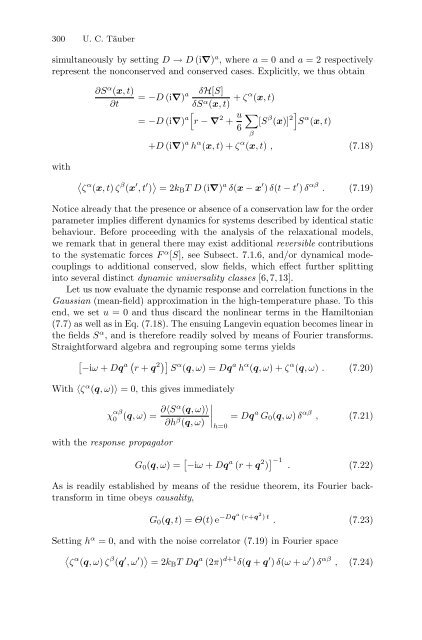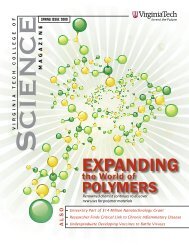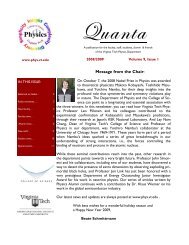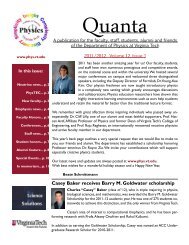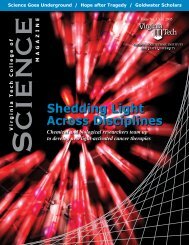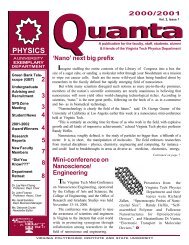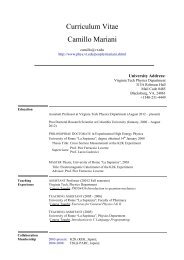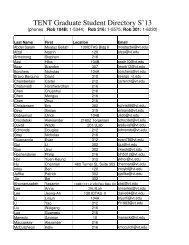Springer Lecture Notes in Physics 716
Springer Lecture Notes in Physics 716
Springer Lecture Notes in Physics 716
Create successful ePaper yourself
Turn your PDF publications into a flip-book with our unique Google optimized e-Paper software.
300 U. C. Täuber<br />
simultaneously by sett<strong>in</strong>g D → D (i∇) a , where a =0anda = 2 respectively<br />
represent the nonconserved and conserved cases. Explicitly, we thus obta<strong>in</strong><br />
∂S α (x,t)<br />
∂t<br />
= −D (i∇) a δH[S]<br />
δS α (x,t) + ζα (x,t)<br />
= −D (i∇) a[ r − ∇ 2 + u ∑<br />
[S β (x)] 2] S α (x,t)<br />
6<br />
β<br />
+D (i∇) a h α (x,t)+ζ α (x,t) , (7.18)<br />
with<br />
〈<br />
ζ α (x,t) ζ β (x ′ ,t ′ ) 〉 =2k B TD(i∇) a δ(x − x ′ ) δ(t − t ′ ) δ αβ . (7.19)<br />
Notice already that the presence or absence of a conservation law for the order<br />
parameter implies different dynamics for systems described by identical static<br />
behaviour. Before proceed<strong>in</strong>g with the analysis of the relaxational models,<br />
we remark that <strong>in</strong> general there may exist additional reversible contributions<br />
to the systematic forces F α [S], see Subsect. 7.1.6, and/or dynamical modecoupl<strong>in</strong>gs<br />
to additional conserved, slow fields, which effect further splitt<strong>in</strong>g<br />
<strong>in</strong>to several dist<strong>in</strong>ct dynamic universality classes [6, 7, 13].<br />
Let us now evaluate the dynamic response and correlation functions <strong>in</strong> the<br />
Gaussian (mean-field) approximation <strong>in</strong> the high-temperature phase. To this<br />
end, we set u = 0 and thus discard the nonl<strong>in</strong>ear terms <strong>in</strong> the Hamiltonian<br />
(7.7) as well as <strong>in</strong> Eq. (7.18). The ensu<strong>in</strong>g Langev<strong>in</strong> equation becomes l<strong>in</strong>ear <strong>in</strong><br />
the fields S α , and is therefore readily solved by means of Fourier transforms.<br />
Straightforward algebra and regroup<strong>in</strong>g some terms yields<br />
[<br />
−iω + Dq<br />
a ( r + q 2)] S α (q,ω)=Dq a h α (q,ω)+ζ α (q,ω) . (7.20)<br />
With 〈ζ α (q,ω)〉 = 0, this gives immediately<br />
χ αβ<br />
(q,ω)〉<br />
0 (q,ω)=∂〈Sα ∂h β (q,ω) ∣ = Dq a G 0 (q,ω) δ αβ , (7.21)<br />
h=0<br />
with the response propagator<br />
G 0 (q,ω)= [ −iω + Dq a (r + q 2 ) ] −1<br />
. (7.22)<br />
As is readily established by means of the residue theorem, its Fourier backtransform<br />
<strong>in</strong> time obeys causality,<br />
G 0 (q,t)=Θ(t)e −Dqa (r+q 2 ) t . (7.23)<br />
Sett<strong>in</strong>g h α = 0, and with the noise correlator (7.19) <strong>in</strong> Fourier space<br />
〈<br />
ζ α (q,ω) ζ β (q ′ ,ω ′ ) 〉 =2k B TDq a (2π) d+1 δ(q + q ′ ) δ(ω + ω ′ ) δ αβ , (7.24)


